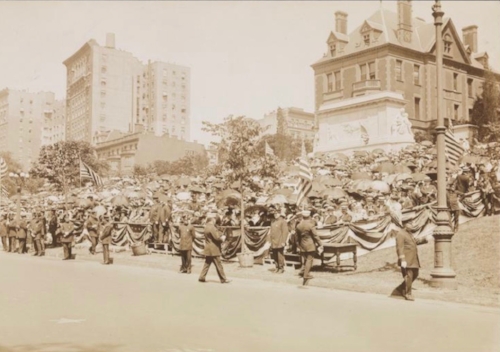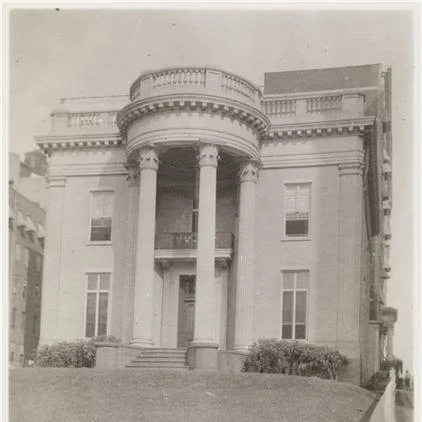Uptown Girls: Former Country Villas and Magnificent Mansions on the West Side between 99th and 114th Streets.
As Manhattan’s population surged northward during the latter decades of the nineteenth century, the formerly rural far reaches of the Upper West Side changed remarkably in character. By 1900, one could find an interesting hodge-podge of former summer homes dating back a century, along with brash newer mansions, middle class townhouses, and apartment buildings. Thanks in large part to the digitization of the photo archives at the New York Public Library and the Museum of the City of New York, this post will look at some the grand homes around Bloomingdale and Morningside Heights as well as what replaced many of them (almost all would disappear by 1930).
Furniss Mansion
Photo: Museum of the City of New York
This elegant white-columned mansion, the core which dated to around 1800, sat on a riverfront estate rising up from the Hudson River between 99th and 100th streets. Purchased by the Furniss family in the 1840s, it was enlarged and embellished several times before they stopped using it as a summer retreat in the 1870s. They in turn rented it out to another family who used it as a summer residence for a couple of decades, then to a woman who ran it as a pseudo-boarding house for writers and artistic types (Gertrude Stein and Vaughn Kester amongst them).
postcard of the Furniss mansion in the early 1900s
In 1909, the Furniss decided to finally sell the property, along with the 23 building lots its grounds encompassed. Needless to say, its days were numbered.
270 and 276 Riverside Drive
Today two large apartment buildings, 270 and 276 Riverside Drive occupy the spot.
Rev. Peters House, 2648 Broadway photo: MCNY
Just east of the Furniss mansion was another home sporting veranda with ionic columns, albeit on a smaller scale. This photograph of 2648 Broadway at Broadway and 100thstreet from around 1910 lists it as being owned by the Rev. J Peters, and formerly owned by J W Tieman. It is possible that JW Tieman was related to Daniel Tiemann, who served as mayor of New York City during the 1850s and whose family owned a large estate comprising over 100 lots a little farther uptown into the twentieth century. Stylistically, it is a fairly textbook example of the Greek revival, indicating it was probably built a couple of decades later than the Furniss mansion.
A huge residential retail building stands in its place today
A little to the north of Rev. Peters home were the handsome residences of David Knapp and David Gorham, proudly standing side by side on 105thstreet off of Amsterdam. The Knapp residence on the left reflects elements of the Italianate style, while the Gorham mansion showcases the greek revival.
I couldn’t find a record of when they were demolished (this photograph dates from 1875) but it was most likely early, as these early brownstone tenements now line the street.
Doegler Mansion photo: nypl archives
Heading back to Riverside Drive, in 1885 Bavarian-born brewer Peter Doegler purchased a large lot on the corner of 100thstreet facing the grounds of the Furniss mansion, employing architect William Schickel to design a large residence and carriage house upon it. The resulting large red brick mansion trimmed in brownstone was completed in 1889. A rather severe interpretation of the Queen Anne style, its effect would have been softened somewhat by gardens which surrounded it on three sides.
Parade on riverside Drive in 1915 with Doegler mansion in background photo:mcny
His family continued to occupy the mansion until his widow’s death in 1925.
Candela-designed apartment building on the spot of the former Doegler Mansion
Soon thereafter it was demolished to make way for this apartment building.
300 Riverside Drive
At the same time plans were underway for Doegler’s new mansion, William F Foster purchased this large mansion at 300 Riverside Drive, on the corner of 102nd. Foster was born in England and made a huge fortune in the glove business. While large, the mansion was too old-fashioned for Foster’s taste. He decided to have it razed, and hired architect Halstead Fowler to replace it with something larger and more fashionable.
The Foster's new mansion
The resulting mansion, completed in 1888 was much more flamboyant than its subdued predecessor, to say the least. Foster lived in his mansion with his wife Bertha until his death in 1895.
300 Riverside Drive to the right
The home lasted until 1922, when it was demolished to make was for this fourteen-story apartment building.
photo:MCNY Digital archives
In 1907 Morris Schinasi, had William Tuthill (the architect of Carnegie Hall) design a 35 room white marble, French renaissance-style mansion for him on Riverside Drive at he corner of 107thSt.. Completed in 1909, mansion miraculously still stands, one of the last freestanding mansions remaining in private hands in Manhattan.
Along with its grand neighboring semi-detached townhouses, it gives a hint of what this section of Riverside Drive once looked like.
Bayne Residence
The property on which the Schinasi mansion was built had previously by banker Samuel Gamble Bayne, who lived on the northern corner of the same block in this stunning Romanesque revival mansion at 355 Riverside Drive. When Gamble moved into his mansion designed by Frank Freeman in 1891 he was no stranger to the area. He had previously lived across the street on the opposite corner of Riverside and 108thin another Romanesque revival mansion (also designed by Freeman in 1887).
a photo of Baynes mansion showing his earlier home right across the strret
Bayne remained in his home through 1921, when he sold it to make way for a 14-story apartment building.
355 Riverside drive which took the place of Baynes mansion
Again, he did not move far for it was soon announced he would take an apartment encompassing the entire top floor of the apartment building rising on the site of his former home.
This home proudly standing at 420 Riverside Drive and 114th street was built around 1836.
The elegant, Greek revival mansion with its refined semi-circular portico had formerly been the residence of Andrew Carrigan, before being purchased by the Rudd family in the 1870s.
Map of the Carrigan estate from the 1870s which occupied 22 building lots, showing the placement of the mansion and stable
Its last owner, Althea Ward Rudd, sold it in 1910 to make way for an apartment building. She must have had a strong attachment to place though,
The Ward Mausoleum
for when she died in 1915, the mausoleum in Greenwood Cemetery she was put to rest in bore a striking resemblance to her former home.



























